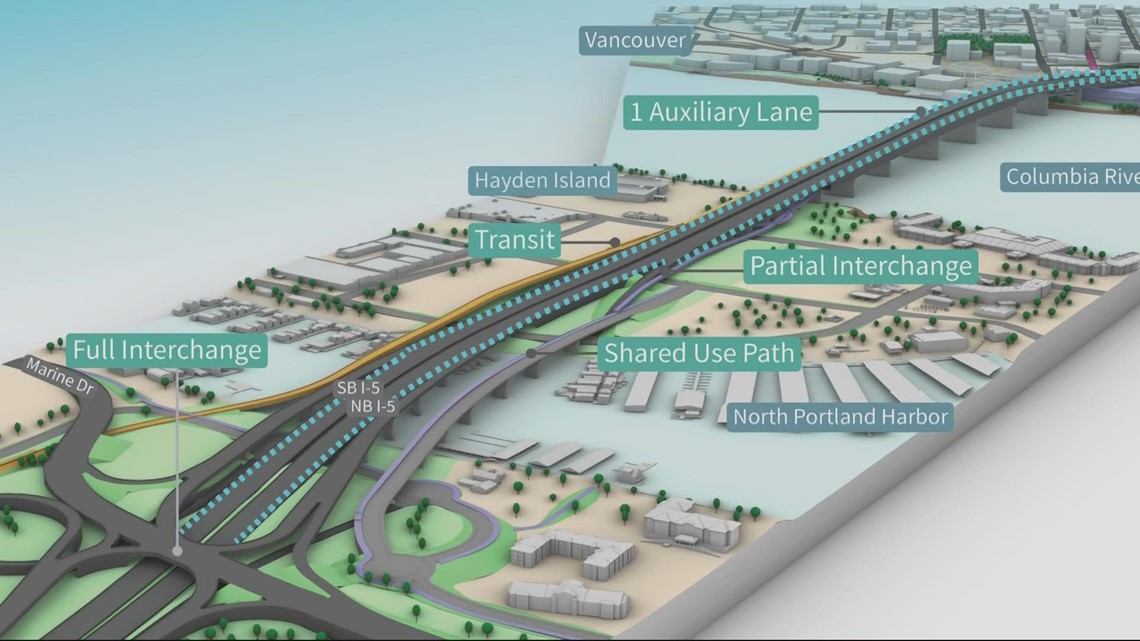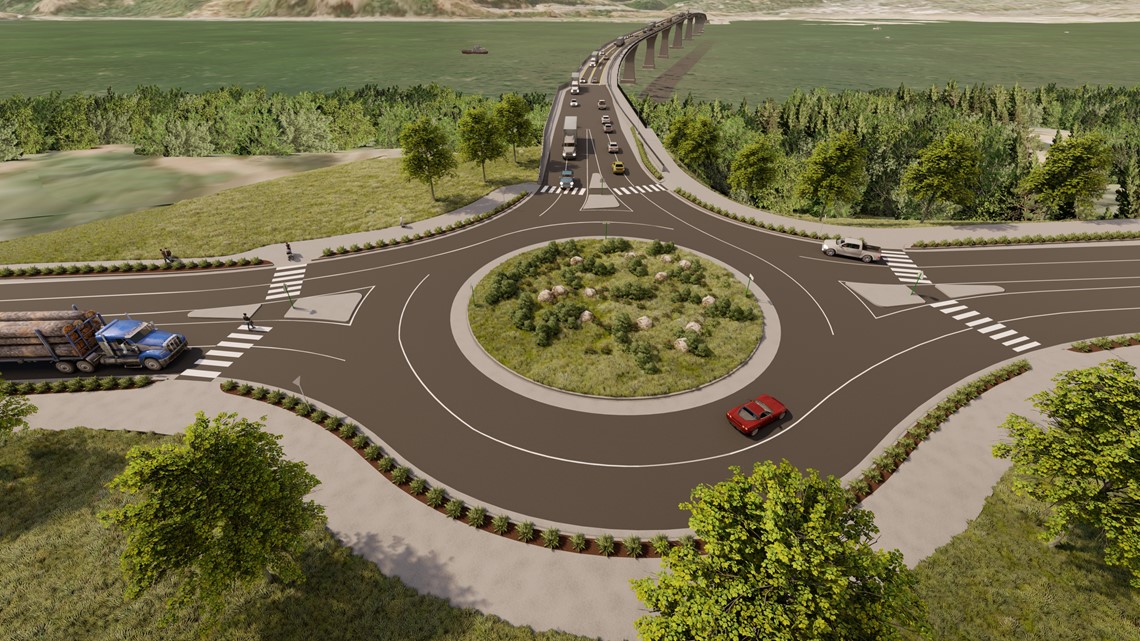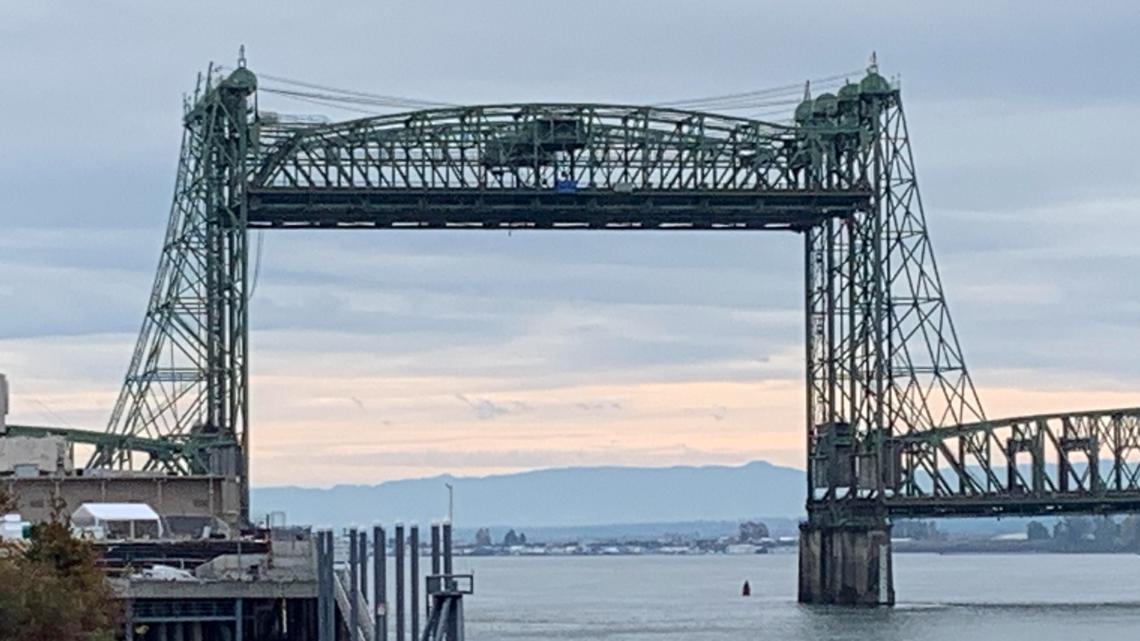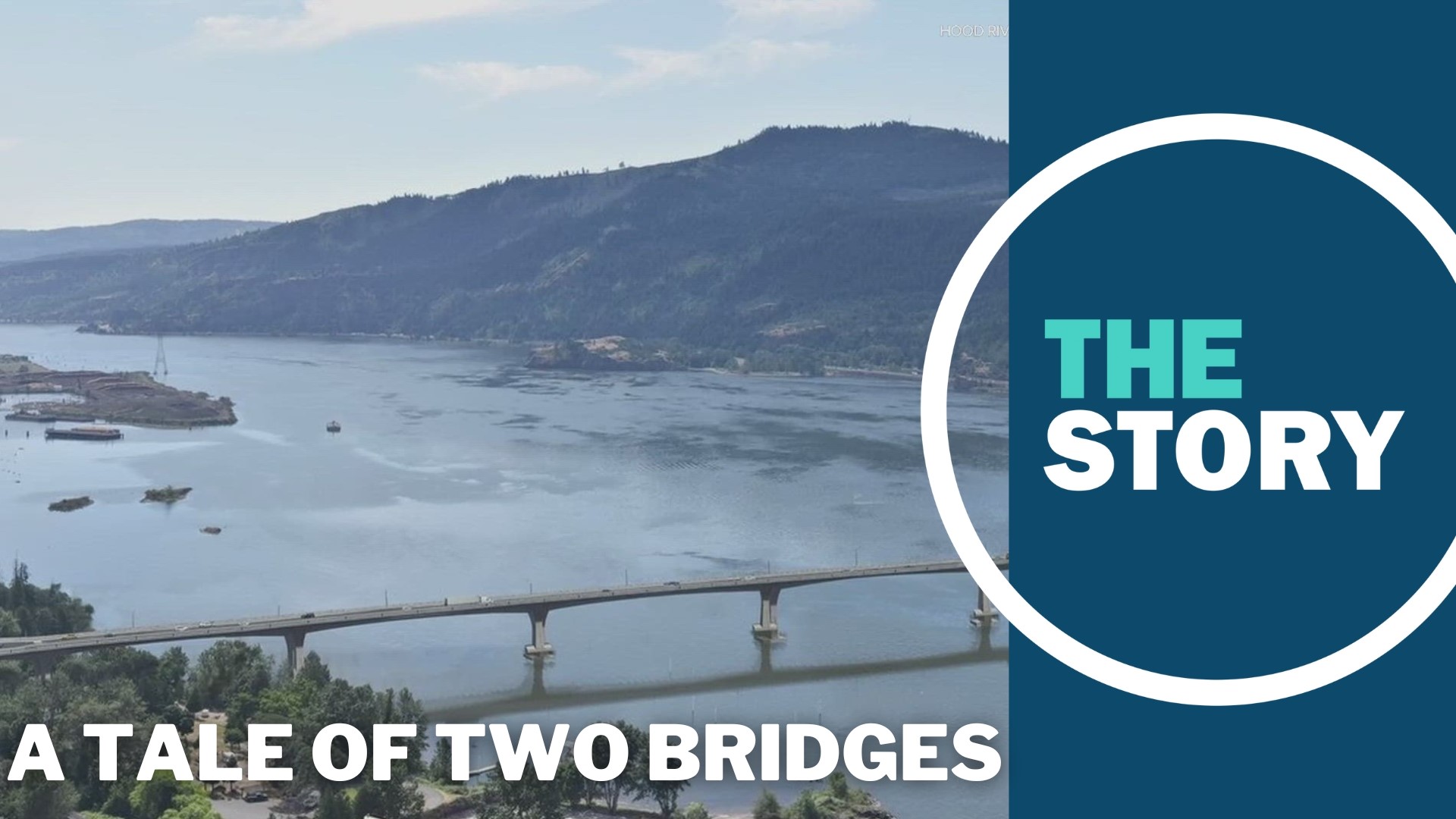PORTLAND, Ore. — A few weeks ago, KGW aired a story about the plan to replace the aging Hood River Bridge across the Columbia River, and the upcoming toll hike that will cover part of the project’s cost. Some viewers couldn’t help but compare the Hood River Crossing to the other big Columbia River bridge project in the works right now — particularly when it comes to the price tag.
A viewer named Kevin asked: "How come it costs $600 million dollars to build a bridge across the Columbia River in Hood River, but $6 billion to build a bridge across the Columbia River in Portland?"
He acknowledged that the planned Hood River Bridge is a lot smaller than the Interstate Bridge replacement — it’s going to be a single bridge with two lanes, rather than twin bridges with four lanes each. But still, if two lanes costs $600 million, then using some back-of-the-napkin math, shouldn’t eight lanes cost about four times that much? That would be $2.4 billion, so how did we get to $6 billion?


Let’s dive in and compare.
For starters, the $2.4 billion figure might be napkin math, but it’s basically on the mark.
Earlier this year, the Interstate Bridge Replacement Program team released what you might call an itemized bill for the project, breaking the $6 billion cost down into different pieces. One of those pieces was the estimated cost for the new bridge and approach ramps alone, and the estimated cost range was roughly $1.6 billion to $2.5 billion.
The $2.4 billion napkin estimate fits in at the high end of the range, seemingly suggesting that the I-5 bridge could wind up being about the same price or cheaper than the Hood River Bridge on a cost-per-lane basis, although there are a couple caveats.
For one thing, the Hood River Bridge is longer than the Interstate Bridge, and the Hood River project's cost estimate also includes all of that project's peripheral components on the north and south shores — but they're a relatively small part of the project.
The Interstate Bridge project has its own peripheral pieces, but they're much larger, which is why the itemized bill lists them separately. When they get added back in, that's what pushes the price tag up to $6 billion.
Light rail and freeway upgrades
The single biggest addition is light rail. The added width to accommodate the rail line is priced into the bridge's cost estimate, but everything else — the tracks, three new stations, another bridge to carry the line to Hayden Island and a viaduct to bring it back down to the ground in Vancouver — falls into a separate cost estimate of about $1.3 billion to $2 billion. That's a cost that the Hood River project doesn't have to reckon with at all.
The itemized bill grouped the remaining additional pieces into two big categories: upgrades on the Oregon side of the bridge and upgrades on the Washington side.


Starting with Oregon, the proposed project plan includes rebuilding or modifying the North Interstate, Marine Drive and Hayden Island I-5 interchanges, as well as a replacement for the smaller bridge that carries I-5 to Hayden Island on the Oregon side. The new Hayden Island interchange will only serve traffic from the Washington side, so the project would also add a new local bridge for drivers to access the island from the Oregon mainland.
All of those components add up to a range of about $1 billion to $1.6 billion, according to the IBR team's estimate.


The Hood River Bridge project will include some upgrades on the Oregon side too, but they’re comparatively simple — just demolishing some Port of Hood River buildings that are in the way and presumably rebuilding the tollbooth.
Back in Portland and jumping over to the Washington side, the Interstate Bridge project will rebuild the downtown Vancouver and Highway 14 interchange, as well as modify the Mill Plain, Fourth Plain and 39th Street interchanges. The IBR team's preferred plan also calls for the new bridge to cross the river at a much higher elevation than the current structure, in order to avoid the need for a new drawbridge. But that means the Highway 14 interchange in particular will be an extensive rebuild with a tangle of very tall new freeway ramps.
All of that adds up to a range of about $1 billion to $1.5 billion, according to the itemized bill.


In Hood River's case, the Washington side upgrades are relatively sparse — mainly just replacing a traffic light intersection with Highway 14 with a traffic circle.
So to answer Kevin's question: yes, it technically would be possible to build a replacement Interstate Bridge for $2.4 billion, or possibly less. Lane for lane, the Hood River and Interstate 5 bridges are relatively similar in cost — but the Hood River Bridge doesn't have to deal with the same bevy of add-on components.
Questioning the add-ons
There was a final part of Kevin's question: "Roughly $3.6 billion for light rail and some lane changes — isn't that a bit much?"
He’s definitely not the only person to ask that question. All of these add-on components have drawn criticism, although not all from the same places. There's a vocal segment of Clark County that favors ditching the light rail component altogether, although the Interstate Bridge project leaders have argued that doing so would cause the project to miss out on as much as $1 billion in federal funding.
Other critics have taken aim all the interchange upgrades, along with the size and height of the bridge itself, arguing that the project is turning into a sprawling freeway expansion instead of a simple bridge replacement.
"They’re literally proposing to rebuild seven interchanges, between Vancouver and the three on the Oregon side of the river," said Portland economist Joe Cortright from City Observatory. "And ironically, when you look at the highway cost to the project — all the elements for moving cars and trucks — it's actually the approaches and the intersections are more expensive than the bridge itself."
Cortright was also a prominent critic of the Columbia River Crossing, the previous iteration of the Interstate Bridge replacement project that fell apart in the planning stages in 2013. He said the current version is making some of the same mistakes, starting with the decision to try to building the new bridge higher up, because it forces a much more extensive rebuilds of the Highway 14 interchange.


The inclusion of so many additional interchanges is also an issue, he said, pointing to a study done back in 2011 for the Columbia River Crossing which found that the seven interchanges in the project zone are all far to close together, and that "reducing and simplifying the number of interchanges would significantly improve both functionality and cost."
"You would never build a freeway like that today," he said. "So if we're — first thing is, from a design standpoint, we ought to get rid of one or more of the interchanges."
It's also a mistake to commit to such a wide-ranging design and project area, Cortright argued, because doing everything at once creates more financial risk if the project goes over budget. It would be safer to break the different components into independent phases, he said, starting with just the bridge itself.
Solving for the whole corridor
KGW reached out to Interstate Bridge Replacement Program Administrator Greg Johnson about the added components, particularly the interchange question. He noted that the IBR project does intend to scale down the Hayden Island interchange, but he said the reason all the others are getting rebuilt or upgraded is precisely because of how closely spaced they are.
One of the project’s goals is to improve traffic flow through the whole corridor around the bridge, he said, and that means the team almost has to treat the seven interchanges as one big interchange, reworking all of them to operate together more smoothly. Shrinking the project's footprint could start eating into the efficiency gains that the team hopes to achieve.
"You start seeing some significant — less significant reduction in congestion the much more you limit this five mile corridor," he said.


But that still leaves one question: If all the interchanges have to be included, couldn't you improve efficiency by combining or eliminating some of them rather than upgrading them all? Johnson said the team did study that possibility, but ran into a more practical problem.
"One of one of the things that's a given in transportation: once folks have an interchange, it is very hard to remove that point of access," he said. "You know, folks for the last 60 years have had interchanges connecting them. Those folks do not want to give those type of things up."
Unlike with light rail, there’s no specific pot of federal money just for interchanges, but Johnson said it’s still important that the project improve efficiency as much as possible, because it’s going to have to compete for federal funding, and federal officials are going to want to see that they're getting the most out of their dollars.
And he did admit that the project is trying to be one big solution to several problems at once — earthquake vulnerability, mass transit to Vancouver, congested interchanges — but he argued that in the long run, that’s the best way to do it.
"If you solve one problem, then you will have to come back later years, at a much higher cost, to try and solve the remainder of the problems in the corridor," he said.

